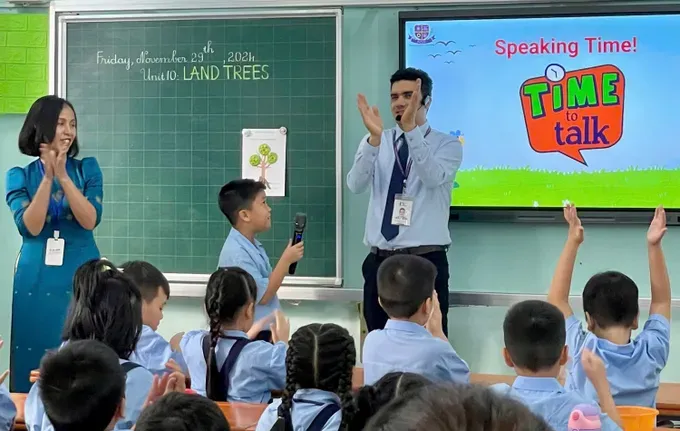
Prime Minister Decision No. 2371/QD-TTg (dated October 27, 2025) officially approved the national project “Introducing English as the Second Language in Schools, 2025–2035, with a Vision Toward 2045.”
The initiative aims to implement the policy set forth in the Politburo’s conclusion No. 91-KL/TW (August 12, 2024), making English the second language in Vietnam’s education system.
Disparities in teacher recruitment across regions
Ho Chi Minh City currently leads the country in terms of school scale. For the 2025–2026 academic year, the city plans to recruit 5,696 teachers, including 505 English teachers across all education levels. Following the first recruitment round in early October, 24 English teaching positions remain unfilled, mainly at primary and lower secondary schools.
According to Tong Phuoc Loc, Head of the Organization and Personnel Department at the HCMC Department of Education and Training, the city will conduct a second round of recruitment to fill remaining vacancies and replace candidates who declined appointments. Encouragingly, the 2025 recruitment process saw strong interest—applications for English teaching positions were triple the available quota, with a record 799 submissions for lower secondary school positions.
In Hanoi, the Department of Education and Training reported nearly 8,000 applications for only 800 teacher openings for 2025–2026, with 6,963 candidates qualifying for the second round. The capital, therefore, has a robust teacher pool, including for English.
In contrast, several provinces face difficulties filling English teaching positions. In Nghe An, the Department of Education and Training recently reassigned 82 English teachers from 52 primary schools to teach across schools via online lessons—a temporary measure to address shortages, particularly in mountainous districts, where 23 schools still lack any English teacher.
English instruction at preschools is expanded
Under the 2018 General Education Program, English is a compulsory subject from Grade 3 onward, while preschool and Grades 1–2 offer it on a voluntary basis. The new project aims to introduce English from preschool, helping children build basic communication skills and readiness for primary education.
According to estimates, each preschool nationwide will need one additional English teacher, requiring around 12,000 new preschool English teaching positions. However, implementation varies widely among provinces. For example, in Ninh Binh, some districts have already introduced English at the preschool level while others have not, resulting in uneven rollout strategies. In Nghe An, despite early adoption, the lack of full-time teachers has forced schools to hire instructors from private language centers, raising tuition fees and facing parent resistance.
Deputy Minister of Education and Training Pham Ngoc Thuong noted that preschool teacher demand will surge in the coming years. He urged local authorities to recognize the crucial role of early childhood educators and called on teacher training institutions to adopt flexible policies to attract talented students to preschool education.
In Ho Chi Minh City, as of the 2025–2026 school year, 2,093 out of 3,937 preschools, accounting for 53.16 percent, offer English exposure activities for 206,811 children, facilitated by 3,489 teachers. However, the coverage remains uneven, concentrated mainly in public schools. To expand access, the city is strengthening partnerships with private organizations and mobilizing additional resources to broaden English learning opportunities for preschoolers.
Three-Phase Implementation Plan
The 'English as a Second Language project' applies to all educational levels nationwide—from preschool to university, including vocational and continuing education. It will unfold in three phases:
- Phase 1 (2025–2030): Establish foundational systems for regular English use in education.
- Phase 2 (2030–2035): Expand consistent English usage across teaching, communication, and administration.
- Phase 3 (2035–2045): Develop a comprehensive English language ecosystem in schools, integrating education, communication, and management.
To achieve mandatory English instruction from Grade 1, Vietnam will need nearly 10,000 additional primary English teachers and must provide professional development and training for at least 200,000 educators by 2035 to meet the project’s ambitious goals.
























